 Kingbird of some kind (Tyrannus sp.), Livingston Co, NY, 22 November
2003. Couch's Kingbird (Tyrannus couchii) X Scissor-tailed Flycatcher (T.
forficatus)?
Kingbird of some kind (Tyrannus sp.), Livingston Co, NY, 22 November
2003. Couch's Kingbird (Tyrannus couchii) X Scissor-tailed Flycatcher (T.
forficatus)? Kingbird of some kind (Tyrannus sp.), Livingston Co, NY, 22 November
2003. Couch's Kingbird (Tyrannus couchii) X Scissor-tailed Flycatcher (T.
forficatus)?
Kingbird of some kind (Tyrannus sp.), Livingston Co, NY, 22 November
2003. Couch's Kingbird (Tyrannus couchii) X Scissor-tailed Flycatcher (T.
forficatus)?
All photographs © Kevin and Jay McGowan, unless otherwise noted.
Most photographs taken with an Olympus D-40 digital camera through a Swarovski AT-80 spotting scope.
 On Sun, 9 Nov. 2003 Gary Chapin discovered a Tyrannus flycatcher
along River Road, Livingston Co., near Geneseo, New York. In his internet report, he
identified the bird as a Western Kingbird citing the white outer feathers which could be
seen when the bird landed. A week later, Matt Victoria photographed the bird and posted
his photos on his website http://www.fickity.com/weki.html
. Jay was reviewing Matt's photos with his sister Perri, and realized that
the bird just didn't quite fit Western Kingbird, and that the huge bill and lack of darker
chest actually fit Tropical/Couch's better. His post spurred others to look more
closely, and now we don't know what it is.
On Sun, 9 Nov. 2003 Gary Chapin discovered a Tyrannus flycatcher
along River Road, Livingston Co., near Geneseo, New York. In his internet report, he
identified the bird as a Western Kingbird citing the white outer feathers which could be
seen when the bird landed. A week later, Matt Victoria photographed the bird and posted
his photos on his website http://www.fickity.com/weki.html
. Jay was reviewing Matt's photos with his sister Perri, and realized that
the bird just didn't quite fit Western Kingbird, and that the huge bill and lack of darker
chest actually fit Tropical/Couch's better. His post spurred others to look more
closely, and now we don't know what it is.
Having seen Tropical Kingbirds in Peru that showed white in the outer tail feathers, I decided to look up some fine details in the collections at the Cornell University Museum of Vertebrates. Looking at the wing formula as shown on the photographs provided by Willie D'Anna, I was guessing it was really a Couch's Kingbird. But Pat Kocinski's video clearly showed white outer tail feathers, as did Kurt Fox's still photographs, which can be seen at http://home.eznet.net/~kfox/wny/weki/tyrannus.htm.
Jay and I went to see the bird for ourselves on Saturday, 22 November 2003, and I am posting here some of the photos we took.
For a reference series of specimens, compiled with this bird in mind, go to my companion page on yellow kingbirds.
For more photos and discussion on this bird, go to http://www.oceanwanderers.com/NYTyrannus.html.
Pat Kocinski has posted two snippets of video showing the bird fan its tail. The clips can be downloaded from this web link.Jim Kimball of Geneseo recorded the "peep" calls of this bird, an example of which can be heard here. He also played calls of Couch's, Cassin's, Tropical, and Western kingbirds, as well as Scissor-tailed Flycatcher. The bird ignored everything except the Couch's Kingbird calls, to which it responded vigorously. (Spectrograms of the call don't really match similar calls of any of the other species.)

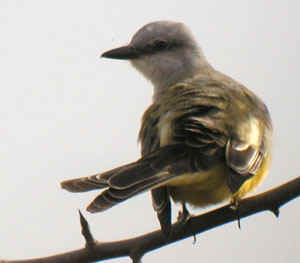

The bird was clearly a large Tyrannus kingbird, showing all the typical fieldmarks of yellow belly, gray head, and all black bill. I was struck immediately by the oddly shaped tail. Perched, it was long and deeply forked, with the central tail feathers being much, much shorter than the outer ones. In flight, the curved, lyre-shape was apparent, quite unlike any other bird I can think of seeing.
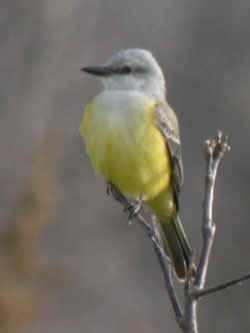
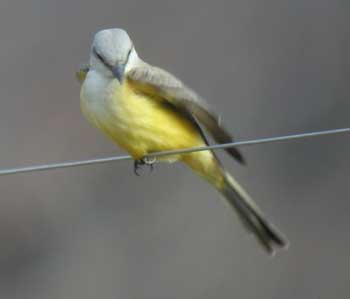
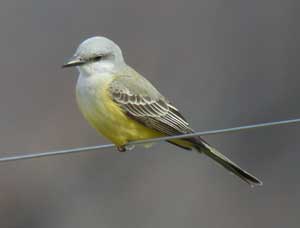
The head was medium gray with darker lores and in a thin line behind the eye (in the auricular area, but only a line or point). The color seemed the same in front and behind the eye. The bill was entirely black, and appeared quite large. It had a very sturdy feel, being longer and thicker than I think of Western Kingbird having, much more along the lines of Tropical Kingbird, or just not quite that large. The terminal hook was apparent, and together with the dusky mask gave it a shrike-like appearance when I got a good look. I noticed repeatedly that the bird had a bit of a rounded crest peaking at the rear of the head. It was particularly noticeable when the bird faced directly at me, and it appeared to be slightly parted down the middle, giving it a slightly heart-shaped head.
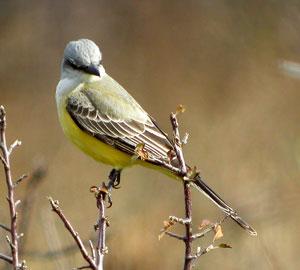
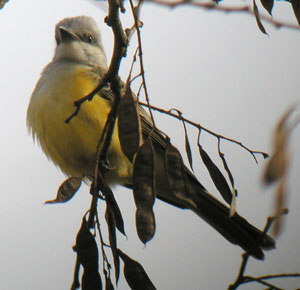
The lower face and throat were pale, pearly gray, nearly white. This color extended onto the chest, especially down the ventral portion. The yellow of the belly extended up the sides above the bend of the wrist (wing). The chest was a somewhat washed-out yellow, but the belly and flanks were a brilliant yellow. Having just spent a lot of time looking at trays of kingbirds in the Cornell drawers, the flanks struck me as a Tropical/Couch's bright yellow, not the medium yellow of a Western Kingbird. The undertail coverts were yellow, but I did not notice them in life. From the photos it appears that they are faded yellow to white.
The back was primarily gray with an olive green wash. The yellowish olive color was obvious, but the ground color was gray. All of the wing coverts and secondaries were heavily edged in whitish. The flight feathers and greater coverts were blackish, about the same shade as the tail. I looked specifically many times, and I could see no contrast between the fresh-looking wing feathers and the newer tail feathers. The wingtips were darker than the faded older tail feathers.
The tail was weird. The central three pairs of tail feathers were clearly of a different generation than the outer three pairs. The newer inner feathers were dark blackish, with white edges around the entire margin of the feather. The older outer feathers were dark, faded-looking brown. They were not edged in white, except for the outermost vane of the outermost pair. Those were white, although they were not as obviously white as I had expected from looking at Pat's video. I could see the dark tip on that feather when it was perched, but I could not see the white extending into the inner vane until I looked at the photos.
The legs and feet were black.
 |
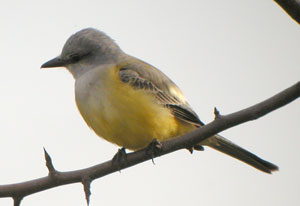 |
| This pair of photos shows how one has to be cautious about judging bill shape in the field. To my eyes, the bill on the left photo looks longer and thicker than the one on the right. The bird has extended its head a little, altering its overall profile, and has raised its crest a bit, making the bill look shorter. In addition, I think it has turned its head slightly away from the camera, causing a bit of foreshortening (the absolute bane of photograph measuring). | |
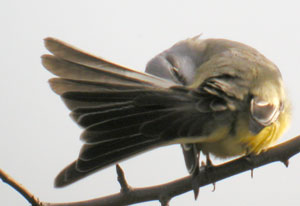 Here is a picture of the bird preening and fanning its tail. The arced shape of the fork is obvious here. |
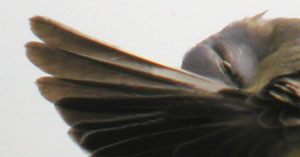 Note the outer web of the outermost tail feather (r6) is white along its entire length, but not at the tip. The inner vane of r6 is white to the rachis (shaft) for just under half its length. |
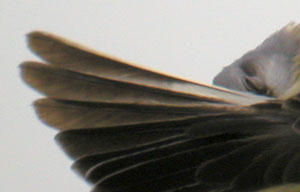 In this second shot it can be seen that the outer vane of r5 is white edged along most of its length (but not near the tip), but that the white does not reach the rachis. It appears to me that the third feather in (r4) also has white edging, but then so do all the rest of the tail feathers. |
 |
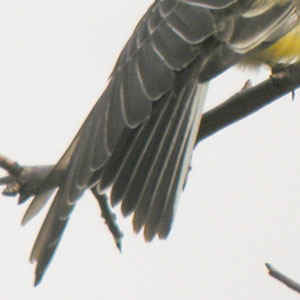 |
| This shot was significantly lightened to bring out the feather edges. |
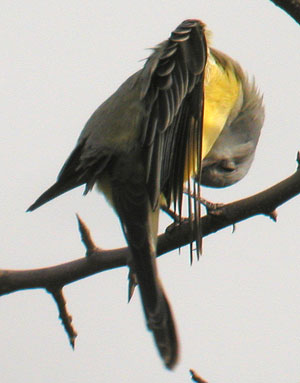
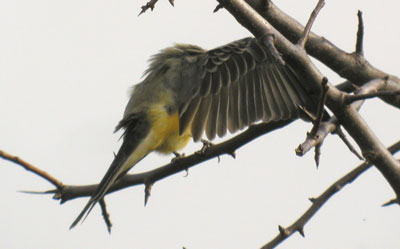
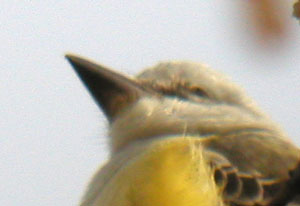
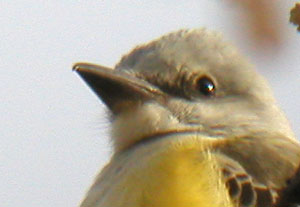
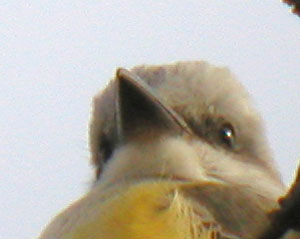
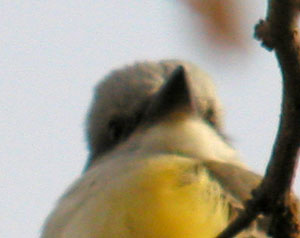

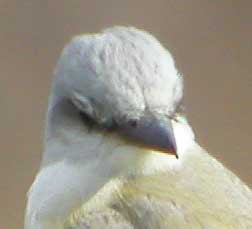
 |
| Here is a slightly fuzzy shot included just in case the color of the tongue is diagnostic. |
Return to the Bad Photos page.
Return to Kevin McGowan's home page.
Go to the Crow Page.
Go to the Cornell Lab of Ornithology's home page